Abstract
The bioeconomy needs new, economically feasible products obtained from biological raw materials via sustainable processes having the smallest possible impact on the environment. The objectives of our study have been: (i) to make an evaluation of the external costs of the production of a poplar extract containing bioactive substances by supercritical extraction; (ii) to make a comparison of the internal and external costs of extract production; (iii) to determine the total life cycle costs (LCCs) of the extract and the break-even prices (BEPs) in two business models. In the first business model (BM I), the only commercial product was the extract, while pellets were used for their own energy purposes. In the second business model (BM II), both the extract and pellets were marketable products. Out of the two analyzed business models, lower external costs and, consequently, lower total costs were achieved in BM I (LCC €259 kg−1) than in BM II (LCC €267 kg−1). However, the profitability analysis showed that BM II was more profitable (BEP €313 kg−1) than BM I (BEP €359 kg−1). The inclusion of the external costs of poplar extract production by supercritical extraction has a significant impact on increasing the production profitability threshold. An analysis of a situation where electricity was replaced with the EU mix (the European Union mix) generated with a higher share of RES (renewable energy sources) showed that the externalities were lowered. A substantial decrease in the external costs at the supercritical extraction stage was reflected in the lower values of the total cost of extract production, LCC, and BEP, hence, attesting to less damage to the natural environment.
1. Introduction
The bioeconomy needs new products obtained from biological raw materials via sustainable processes with the lowest possible impact on the environment, which is a challenging task [1]. Biomass, including bioenergy crops, is expected to take part in reducing CO2 emissions [2], in energy supply, and in the European energy policy. Such production must also be economically feasible for the products to be marketable. Bioeconomic implementation needs sustainable biomass production and sustainable bioproducts on the market. Perennial industrial crops, like poplar cultivated on marginal land, may at least partially fulfill the demand for sustainable biomass [3,4,5,6,7,8]. The biorefinery concept, where biomass produced for bio-based products can also be used for energy generation, is an effective tool for bioeconomic implementation. Perennial industrial crops are a source of many valuable substrates for bioproducts, including bioactive compounds (such as carotenoids, flavonoids, polyphenols, tocopherols, and chlorophylls) [9,10,11,12]. In view of the above, poplar can be considered as a raw material for sustainable bioproducts [13,14,15].
The life cycle assessment (LCA) is a tool that allows one to determine the effect of a product on the environment [16]. The LCA enables the evaluation of the environmental impact in many areas, e.g., ReCiPe 2016 can determine the impact in categories, such as global warming, stratospheric ozone depletion, ionizing radiation, ozone formation, human health, fine particulate matter formation, ozone formation, terrestrial ecosystems, terrestrial acidification, freshwater eutrophication, marine eutrophication, terrestrial ecotoxicity, freshwater ecotoxicity, marine ecotoxicity, human carcinogenic toxicity, human non-carcinogenic toxicity, land use, mineral resource scarcity, fossil resource scarcity, and water consumption. An inventory of all these elementary flows, which is a component of this method, allows the user to determine the size of a given impact.
Another requirement is to attain profitability for making a given product. Many studies have analyzed the cost-effectiveness of a product, but it is only by taking into account any economic calculations of the external costs, i.e., the monetary reflection of the analyzed production process on the environment, that a sustainable evaluation of this product is possible. In practice, the analysis of the cost-effectiveness of production has been reported in the literature quite often, but few articles have taken into account the external costs [17]. Results obtained according to the concept of LCC and externalities indicate the economic benefits of and reduction in CO2 emissions [18].
The completion of a full analysis of production costs requires making an inventory of all the costs related to the production and to the handling of production waste, especially nowadays, when the effect of greenhouse gas (GHG) emissions on climate change has been confirmed and is seen as the largest market failure [19]. Moreover, the fact that airborne pollutants raise the risk of morbidity and mortality due to pulmonary diseases [20], e.g., chronic pulmonary obstructive disease or lung cancer [21], indicates that any industrial production can affect the environment, often causing its deterioration. Despite the existing system of payments for CO2 emissions, Drudi et al. [22] made an assertion that the effects of people’s economic activity have still been underestimated and are not properly taken into consideration in financial markets. It is not always possible to restore the environment to its previous condition, and even when it is—any effort at its restoration will incur considerable expenditures. Thus, it is necessary to estimate the external costs that would be incurred to restore the earlier state of the environment wherever possible [23].
The literature provides examples of methods applied to assess the effect of a given product or service, determined with the use of a life cycle assessment [24,25], and for which the scope included the monetary valuation of external costs [26,27,28]. Although such methods have been known for quite a long time, they are still rarely employed for the internalization of external environmental costs in life cycle cost analyses [17]. The debate about externalities is by no means new, either, as it started over twenty years ago [29,30], and some monetary valuation factors were developed more than ten years ago [31].
Over the years, many methods for the monetization of environment-related externalities have been designed, e.g., Ecotax [32], Ecovalue12 [33], EVR [34], EPS [35], the Environmental Prices Handbook [36], Stepwise2006 [37], LIME [38,39], IMPACT 2002+ [40], the ExternE [41], Budget constraint [42], and USEtox [43]. All these methods have been described in detail and compared by some researchers, e.g., Pizzol et al. [44], Arendt et al. [45], and Amadei et al. [31]. These comparisons led to the identification of certain difficulties in the employment of the above methods, for example, by the fact that the values of the monetary valuation factors in different methods differ sometimes by up to three orders of magnitude [31].
Discussions about the external costs in energy production, especially from fossil fuels, have also been going on for quite a long time [46,47]. The literature has a growing number of references dealing with externalities connected with the production of biomass [48], especially for energy purposes [49,50,51] An LCC analysis including externalities has also been employed in the assessment of chemical [52,53] or petrochemical products [54]. However, there is a scarcity of articles about the externalities of the production of bioproducts from lignocellulose biomass derived from perennial industrial crops.
The following questions arose from the above considerations: What are the amount and structure of the externalities for producing extracts and pellets from poplar? Under which economic conditions would the production of poplar extracts inclusive of externalities be profitable? Earlier studies on the costs of the production of biomass from poplar [49] and costs of the production of poplar extracts [55] have justified the following working hypothesis: the inclusion of the external costs of poplar extract production by supercritical extraction has a considerable impact on elevating the profitability threshold. Hence, the purpose of this study has been: (i) to make an assessment of the external costs of the production of a poplar extract containing bioactive substances; (ii) to compare the internal and external costs of the production of this extract; (iii) to determine the total life cycle costs of the extract and break-even prices in two business models.
2. Materials and Methods
2.1. Scope
The scope of the research comprised an analysis of the environmental life cycle costs, including the external costs of extract production. The extract, described by Ostolski et al. [11] as containing bioactive substances, was produced from poplar (Populus nigra × P. maximowiczii) in a supercritical extraction process. The system boundaries enclosed the following three subsystems: subsystem I comprised the production of poplar biomass and dry poplar chips; subsystem II comprised the biomass logistics and pretreatment; subsystem III included a biorefinery, where the main product, poplar extract, and the co-product, pellets, were made (Figure 1). The first subsystem included the cultivation of poplar in a one-year cycle and the harvest and preparation of dry chips; the second subsystem comprised the transport to a pre-treatment plant, where dry chips were ground and transported to a biorefinery, that is, to subsystem III. The poplar extract and pellets were made in the biorefinery. The process of making the extract comprised the following steps: biomass moisturization, supercritical extraction, unloading–washing, extract drying, and extract packing. Post-extraction biomass was used for pellet production. The description of the whole system, specification of the production costs, and descriptions of the consecutive production stages, chemical and market characteristics of the product, and life cycle cost of the extract can be found in our earlier paper [55].

Figure 1.
System boundaries for the economic analysis [55].
The assumption for the system boundaries was described in earlier paper [55] and it was to make 3.75 kg of extract in one production cycle from poplar yield 8.75 Mg ha−1 year−1 d.m. The annual production of the extract was 915 kg. The post-extraction biomass was used for making pellets. The annual production of pellets was 61.05 Mg year−1. The amount of raw material used for production was 61.92 Mg year−1 and the transport distance in subsystem II was 2 × 50 km. The analysis spanned 20 years for both the poplar plantation and the supercritical extraction plant and the remaining machines and equipment. The discount rate assumed for the analysis was 5%. Two business models were submitted for analysis. The first business model was denoted as BM I, in which the only marketable product was the extract, while the pellets obtained in the production process were used for their own energy purposes to generate the heat needed in the supercritical extraction process. The second business model, denoted as BM II, added pellets as another marketable product. The economic analysis was performed with the support of Invest for Excel (version 3.9) software, developed by the company DataPartner (Porvoo, Finland).
2.2. Costs Analysis
The analysis of the costs for producing 1 kg of extract containing bioactive substances covered an assessment of the total costs in the production value chain. Our previous article [43] presented an analysis of the internal costs for particular subsystems and stages in the production of extracts. This paper, by analogy, shows the external costs for particular subsystems and stages in the production of extracts. The sum of the internal and external costs allowed us to determine the total costs and LCC for producing 1 kg of extract in both business models.
The estimate of the internal costs covered an analysis of the capital expenditure (CAPEX), operating expenses (OPEX), life cycle cost (LCC), and break-even price (BEP) of the production of extracts from poplar chips via supercritical extraction and the co-production of pellets from the poplar biomass. A detailed analysis was presented in the article by Olba-Zięty et al. [55].
An assessment of the external environmental costs of extract production was carried out based on the size of the impact on the environment in impact categories determined with the help of a life cycle assessment (LCA) according to the ReCiPe 2016 Midpoint (H) methodology and the monetary value of the impact category [56] per 1 kg of extract (Table 1).

Table 1.
External costs of extract and pellets per 1 kg of extract production (€ kg−1) in particular production stages and impact categories.
2.3. Profitability Analysis
Based on the value of the total costs in both business models, a profitability analysis was carried out, in which the break-even price (BEP) of the extract was determined, and the minimum income was calculated at which the production would be on the threshold of profitability, i.e., the net present value (NPV) in both business models would be zero. In addition, the theoretical revenue for the highest BEP value in all the business models was calculated.
2.4. Sensitivity Analysis
The sensitivity analysis was an evaluation of the two business models under the conditions in which supercritical extraction would be carried out with the use of the European Union (EU) electricity mix. The models were denoted as follows: BM I EU—the production of the extract and pellets, where the extract was a marketable product and the pellets were used for their own energy purposes, using the EU electricity mix at the stage of the supercritical extraction; BM II EU—the production of the extract and pellets as two marketable products, using the EU electricity mix at the stage of the supercritical extraction.
The sensitivity analysis also comprised an analysis of the effects of changes in the dis-count rate, income, CAPEX, and OPEX on the NPV and involved calculations in the following ranges of change: −20%, −10%, +10%, and +20%. The values of the NPV were calculated for all the business models.
Another aim of the sensitivity analysis was to evaluate the effects of the particular cost components at all the production stages, divided into internal costs and external costs in the range of ±10%, on the changes in the internal rate of return (IRR) and net present value (NPV) by plotting tornado diagrams. This method enabled us to determine the effects of changes in the cost size on changes in the IRR and NPV; moreover, it showed the costs in order from the cost for which the change induced the largest changes in both indices to the cost for which the influence on the changes in the IRR and the NPV was the smallest.
2.5. Statistical Analysis
The statistical analysis of the data was carried out with the help of Monte Carlo simulations and Friedman’s ANOVA with Kendall’s concordance coefficients. The first analysis concerned the confidence intervals for the NPV and expected value of the NPV. The boundary conditions for the Monte Carlo simulations comprised the prices of the poplar extract (Table 2). The minimum value was assumed to be the BEP of the extract calculated according to internal costs. The expected values corresponded to the BEP in particular variants in the business models adopted for the analysis. The maximum prices were assumed based on a study by Viganó et al. [57], who conducted an economic analysis for supercritical fluid and pressurized liquid extractions of phytonutrients from passion fruit byproducts. The standard deviation was calculated based on the standard deviation achieved in marketing studies on the willingness to pay a higher price for a bio-product, and the standard deviation was 16.199% [58]. The Monte Carlo analysis was performed with the support of Invest for Excel (version 3.9) software, developed by the company DataPartner.

Table 2.
Data for Monte Carlo simulations.
The second stage of the statistical analysis comprised an analysis of the significance of the differences between the internal and total BEPs. The analyzed business models were taken as research samples, which resulted in four replications. Considering the character of this study (dependent samples) and lack of a normality of distribution, Friedman’s ANOVA and Kendall’s concordance coefficients were selected as an analytical tool. Friedman’s ANOVA is a non-parametric alternative to one-way repeated measures analysis of variance. The test enabled us to determine whether the total BEP values were significantly higher than the internal BEP values at a significance level of α = 0.05. Friedman’s ANOVA with Kendall’s concordance coefficients was conducted using the STATISTICA 13.3 package (TIBCO Software, 2017).
3. Results and Discussion
3.1. Cost Analysis
The internal cost of the extract production, based on previous studies, was estimated at €105,300 in the first year [55]. The external costs calculated in this manuscript for the first business model (BM I), where the only marketable product was the extract, while the pellets obtained in the process were used for the process itself, were estimated at €122,011 in the first year (Table 3). The inclusion of the pellets as a marketable product increased the external costs to €130,408 in the first year in the second business model (BM II). The highest costs, both internal and external, were in subsystem III, that is, the biorefinery in which supercritical extraction was carried out. The costs incurred in subsystem I, that is, the production of poplar chips, or in subsystem II, that is, the transport between the subsystems and the cost of grinding poplar chips, corresponded to barely 2 and 1% of the total costs, respectively. The LCCs of 1 kg of poplar extract containing bioactive substances were €259 in BM I and €267 in BM II, depending whether the pellets were used for their own energy purposes (BM I) or marketed (BM II). Of these costs, in BM I, a total of €146 corresponded to internal costs, while the external costs connected with the impact on the environment were €113 in BM I and €121 in BM II. The analysis of the business models in which supercritical extraction was carried out using the average electricity mix for 27 EU member states, including BM I UE (where the extract was the only product for sale, while the pellets were used for their own energy purposes) and BM II UE (where both the extract and pellets were sold as marketable products), showed that the external costs could be lowered considerably, by approximately 44% and 34%, respectively (Table 3).

Table 3.
Cost estimation of extract production in the analyzed business models.
The share of energy from renewable sources in electricity generation from all sources was, on average, twice as high in the EU as in Poland (Table 4), which considerably decreased the external costs. The total LCCs derived from the calculation of discounted cash flows per 1 kg of extract were €259 in BM I UE and €267 in BM II EU, that is, in the models where pellets were used for their own energy purposes or were a marketable product, respectively. The LCC external costs would be €113 and €123, respectively. The external LCCs for BM I EU and BM II EU are around 65% of the external LCC derived from the total externalities generated by the impact on the environment in Poland, owing to the high contribution from coal to the production of electricity. According to Lu et al. [59], the transition to RES generates substantial social benefits for EU member states.

Table 4.
Share (%) of RES in electricity generation from all sources [60].
The analysis of the externalities in the individual stages in the first year of production was presented as undiscounted values. The highest external costs were connected with the process of the supercritical extraction of 1 kg of extract and equaled €123 and €131 in BM I and BM II, respectively (Figure 2). An increase in the share of RES in electricity generation (that is, the use of electricity from the average EU mix) in that production stage would have decreased the externalities to €75 and €85 in BM I EU and in BM II EU, respectively. The influence of the extraction method was of key importance in the evaluation of the external costs. Similar results were obtained by Carlqvist et al. [24], who found that an increase in the share of RES in the production of energy used in the extraction process considerably decreased the impact on the environment, thereby lowering the external costs of the extract production. The average external costs of the generation of electricity from coal (1 kWh) were estimated at US$0.145 (€0.123), while the average external costs for producing electricity from biomass were assessed at US$0.059 (€0.050) [48]. The latter was nearly 2.5-fold less than the former, which proves the significant effect of such an energy-consuming process as supercritical extraction on the external costs.
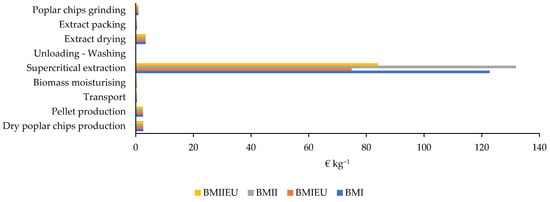
Figure 2.
External costs of production of 1 kg of extract in individual production stages in the analyzed business models.
The subsequent stages generated lower external costs, namely, €2–3 owing to the drying of poplar chips, pellet production, and extract drying. Calculated per 1 Mg of produced pellets, the external costs reached about €36 at either of these stages. In their studies, Saosee et al. [61] and Saosee et al. [51] estimated the internal and external costs of pellet production from the biomass of fast-growing trees—Acacia (harvested every 5 years—yield of 63 Mg ha−1 d.m. per 5 years, which used to be 12.6 Mg ha−1 year−1 d.m.) and Leucaena (harvested every year—yield of 19 Mg ha−1 year−1 d.m.). The authors determined that the external costs were lower for the production of biomass chips, from $4.39 Mg−1 (€4.01 Mg−1) to $ 6.35 Mg−1 (€5.93 Mg−1), while those for pellet production were from $1.93 Mg−1 (€1.80 Mg−1) to $12.73 Mg−1 (€11.89 Mg−1). However, it should be mentioned that in our study, the extract was produced from perennial plants cultivated on marginal land that was usually harvested for energy purposes in 3–4 year cycles and for which the yield per hectare was, therefore, lower, i.e., 22.2 Mg ha−1 year f.m. and 8.75 Mg year−1 d.m. In another study, the external costs of poplar production in a four-year cycle were, on average, €15.67 Mg−1 d.m. (from €11.77 Mg−1 d.m. to €18.76 Mg−1 d.m., depending on the soil amendment scenario), and the yield ranged from 5.48 Mg ha−1 year−1 d.m. to 10.49 Mg ha−1 year−1 d.m. [62]. The values of the externalities calculated for willow, depending on the willow variety, were even higher, namely, €29.2 Mg−1 d.m. on average (from €21.5 Mg−1 d.m. to €55 Mg−1 d.m.) [50], with a yield from 3.6 Mg ha−1 year−1 d.m. to 18.5 ha−1 year−1 [5]. The remaining production stages generated external costs of less than €1 (Figure 2).
The shares of the internal costs and external costs in the total cost varied depending on the production stage that was considered but were similar in all the business models, including BM I (Figure 3) and BM II (Figure 4) and in BM I EU (Figure 5) and BM II EU (Figure 6). The lowest share of the external cost was calculated for the biomass moisturization and unloading–washing stages (ca. 1%), followed by extract drying and extract packing (ca. 20%) and transport (ca. 25%). The highest share of the external cost occurred in the stage of the supercritical extraction, i.e., ca. 67% in BM I, where pellets were used for their own energy purposes, and in BM II, where pellets were a marketable product, followed by ca. 56% in the models where the electricity used in supercritical extraction was the average EU mix and in which pellets were used for their own energy purposes (BM I EU) and where pellets were a marketable product (BM II EU).
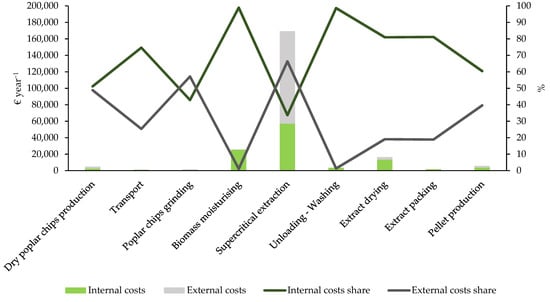
Figure 3.
Internal and external costs and their shares in the cost of extract production per year in the business model in which the extract was a marketable product and pellets were used for their own energy purposes (BM I).
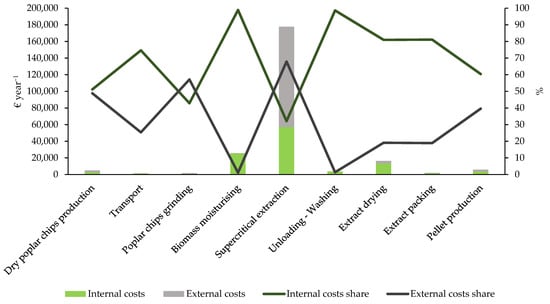
Figure 4.
Internal and external costs and their shares in the cost of extract production per year in the business model in which the extract and pellets were both marketable products (BM II).
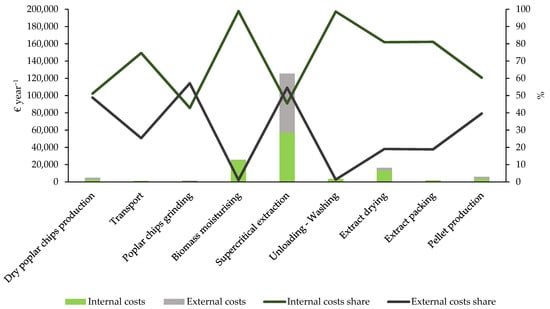
Figure 5.
Internal and external costs and their shares in the cost of extract production per year in the business model in which the extract was a marketable product, pellets were used for their own energy purposes, and the electricity used for supercritical extraction was the average EU mix (BM I EU).
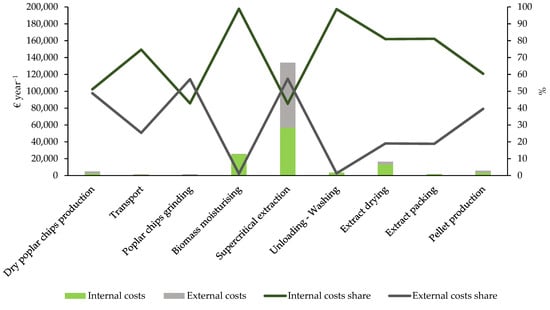
Figure 6.
Internal and external costs and their shares in the cost of extract production per year in the business model in which the extract and pellets were marketable products, and the electricity used for supercritical extraction was the average EU mix (BM II EU).
Sovacool et al. [47] determined that the value of the levelized costs of energy (LCOEs) for coal were in the range from $0.06 kWh−1 to $0.15 kWh−1 (from €0.05 kWh−1 to €0.14 kWh−1), yet the mean externality was $0.14 kWh−1 (€0.13 kWh−1). Such a high value for the external costs in comparison to the LCOE, which could be compared to the internal cost of the supercritical extraction (where the main cost factor was the electricity), explains the high share of the external costs in comparison to the internal costs in this process.
Epstein et al. [63] determined that accounting for environmental damage doubles the price of electricity generated from coal, which means that energy derived from renewable sources becomes economically competitive. Moreover, the internalization of costs arising from damage to the environment and public health in the prices of electricity would increase the costs of energy generation from fossil fuels, which have a stronger impact on the environment. This would be a useful measure to indicate the actual costs of energy, and it would make energy derived from fossil fuels less competitive than energy derived from renewable resources [45].
The highest external costs divided into impact categories were connected with the category of global warming, where they reached €66 and €68 in BM I and in BM II, respectively (Figure 7). The lowest external costs (about €20) were attainable by increasing the contribution of RES to the energy generation, as shown by the results of our analysis. The externalities due to global warming in the models where the electricity used in the supercritical extraction was the EU mix and where pellets were used for their own energy purposes (BM I EU) or where pellets were a marketable product (BM II EU) equaled €43 and €45. The share of the external costs associated with global warming corresponded to around 50% of all the externalities.
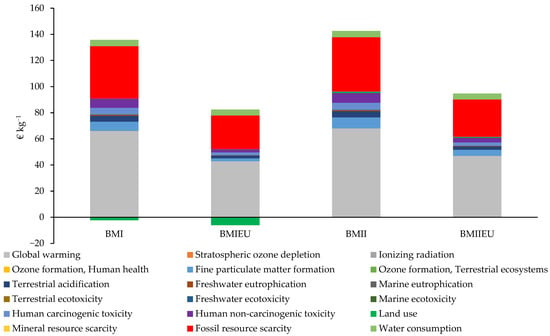
Figure 7.
External costs of the production of 1 kg of extract within the environmental impact categories in the analyzed business models.
The second category burdened with considerable external costs was fossil resource scarcity. The value of the externalities in this category reached ca. €41 in BM I, where pellets were used for their own energy purposes, and ca. €27 in the models where the electricity used for the supercritical extraction was the EU mix and pellets were used for their own energy purposes (BM I EU) or were a marketable product (BM II EU). The impact on the environment in this category could also be diminished by raising the share of RES in electricity generation. The use of pellets for their own energy purposes (in both business models) enabled a benefit of around €2 to be obtained in BM I and €6 in BM I EU in the land use category. The sale of pellets on the market in BM II and BM II EU generated additional external costs of about €1 instead of benefits.
The external costs in the other impact categories were much lower. For example, in the fine particulate matter category, they ranged from €8 in BM I, where pellets were used for their own energy purposes, to €7 in BM II, where pellets were a marketable product, and even lower, down to €5 and €2 in the comparative business models, where the electricity used for the supercritical extraction was the EU mix, i.e., BM I EU, where pellets were used for their own energy purposes, and BM II EU, where pellets were a marketable product. Although the externalities in the fine particulate matter category were lower, the RES share still had a notable influence on lowering the external costs in this category, which is important in view of its effect on the respiratory system and the incidence of respiratory diseases in humans [20]. Although the positive influence of RES on decreasing external costs was evident, the production of poplar (as well as willow) generates external costs due to field emissions in the particulate matter formation category [49,50]; however, research results show that these costs were much lower than the ones generated using coal for producing electricity. Similar tendencies can be observed when analyzing categories, such as human carcinogenic toxicity, human non-carcinogenic toxicity, and terrestrial acidification, where external costs of €5–6 could be reduced to €2. These results are important in the context of the findings reported by Treyer et al. [64], who suggested that the consequences arising from climate change, toxicity to humans, and formation of solid particles are the main factors influencing the overall health of the human population. The other impact categories were loaded with externalities of less than €1.
Our analysis of the external costs in the individual impact categories at the consecutive extract production stages showed that the external costs were the highest at the stage of the supercritical extraction in the global warming category (€62 in BM I, where pellets were used for their own energy purposes, and €64 in BM II, where pellets were a marketable product) but were lower by around €20 in BM I EU and BM II EU, i.e., in the business models where the electricity used for the supercritical extraction was the EU energy mix. High external costs were also detected in the fossil resource scarcity category (€38 and €37) in BM II, where pellets were a marketable product, and in BM I, where pellets were used for their own energy purposes, and €25 and €24 in the BM II EU and BM I EU models, where the electricity was the EU mix and pellets were a marketable product (former) or used for their own energy purposes (latter) (Figure 8, Figure 9, Figure 10 and Figure 11). The contributions of the other categories at the remaining production stages were marginal, less than €1. Special attention should be given to the fact that the use of pellets produced from post-extraction biomass as the source of heat for producing the extract enabled a further reduction in the external costs of the supercritical extraction by €9 in BM I and €7 in BM I UE, particularly in the categories of land use, global warming, fossil resource scarcity, and fine particulate matter formation. In their LCA of the supercritical CO2 extraction of coffee beans, De Marco et al. [65] achieved a substantial reduction in the impact on the environment in a model in which the electricity for the extraction process was supplied from photovoltaic panels. It is worth noting that supercritical extraction is a process that enables one to potentially avoid external costs occurring in other extraction methods because it does not use toxic solvents [66] and limits CO2 emissions by creating an alternative to CO2 [67,68].
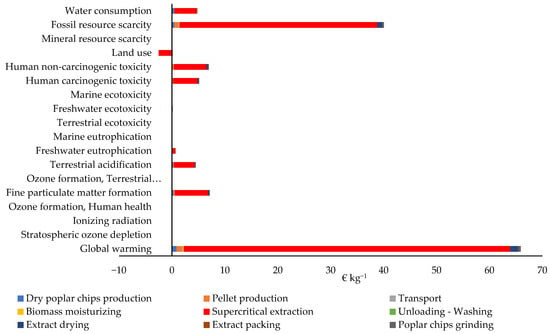
Figure 8.
External costs in the environmental impact categories divided into stages of extract production in BM I, where pellets were used for their own energy purposes.
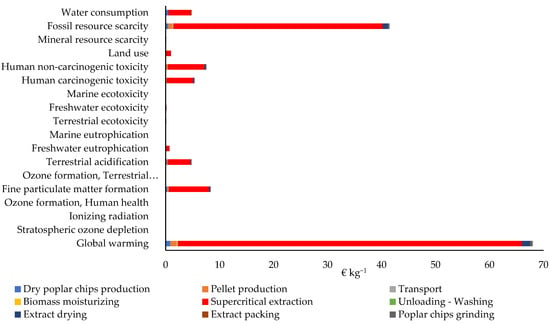
Figure 9.
External costs in the environmental impact categories divided into stages of extract production in BM II, where pellets were a marketable product.
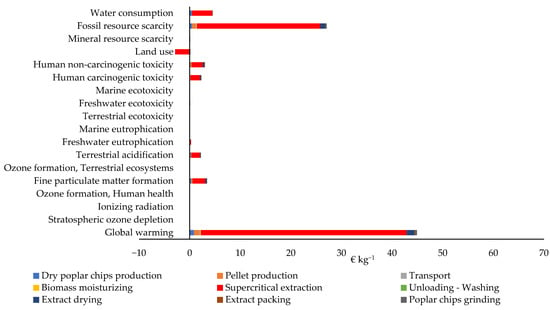
Figure 10.
External costs in the environmental impact categories divided into stages of extract production in BM I EU, where pellets were used for their own energy purposes and the electricity used for the supercritical extraction was the EU energy mix.
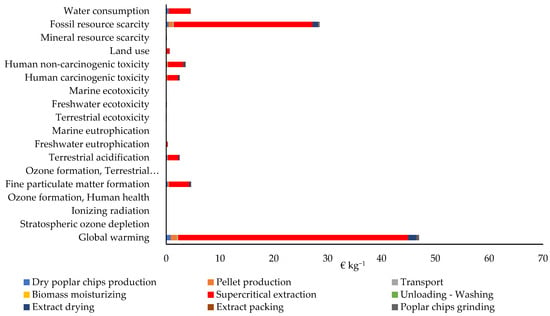
Figure 11.
External costs in the environmental impact categories divided into stages of extract production in BM I EU, where pellets were a marketable product and the electricity used for the supercritical extraction was the EU energy mix.
3.2. Profitability Analysis
The profitability analysis was started by determining the break-even price (BEP) (Figure 12). The highest BEP of €359 per 1 kg of extract was identified in BM I, where pellets were used for their own energy purposes. Although the external costs in BM II were higher, the income from the sale of the other product, that is, pellets, surpassed the rise in the external costs resulting from the inclusion of pellets in the supply of energy sources for their own needs. The income earned from selling pellets led to a decrease in the BEP of the extract to €313. In BM I EU and BM II EU, that is, in the models where the electricity used for the supercritical extraction was the EU energy mix, the external costs were much lower, and the BEP values determined for BM II EU and BM I EU were comparable, namely, €267 and €265. Another way to reduce production costs is to increase the scale of the production, which has been verified in the research of Canabarro et al. [69]. An extraction plant possessing 2 × 100 dm3 extractor tanks becomes profitable at an extract price as high as €500 kg−1. Viganó et al. [57] also demonstrated that a rise in the scale of an installation leads to a reduction in the unit costs of extract production. The analyzed extraction was carried out in an extraction plant equipped with two extractors, each having a 250 dm3 capacity, but the cost of production was estimated based on the cost obtained in a pilot plant equipped with two extractors, each having a capacity of 25 dm3.
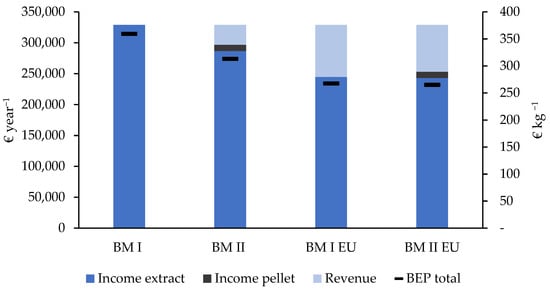
Figure 12.
Incomes, revenues, and break-even prices depending on business models.
The income that must be generated to obtain a zero NPV (calculated based on the total costs) resulted from the sales’ break-even price. The highest income, at the threshold of profitability, resulting from the highest BEP, was obtained in BM I, where pellets were used for their own energy purposes and in the first year of the analysis, it was determined to amount to €328,767; in turn, the income at the threshold of profitability in BM II, where pellets were a marketable product, should reach the value of €296,908. In the analogous models, BM I EU and BM II EU, where the electricity used for the supercritical extraction originated from the EU mix, the expected annual income was around €250,000 owing to the lower BEP values. The income generated from selling pellets made up just 4% of the total income, but it was sufficient for this business model (i.e., BM II) to be more profitable than BM I, where pellets were used for their own energy purposes. The most profitable business model, however, comprised the use of the EU energy mix at the stage of the supercritical extraction. If it was possible to obtain a price of €359 kg−1 for the extract (i.e., the BEP in BM I), then the revenue in BM I would be zero, while in BM II it would be €31,859 year −1; even higher revenues could be achieved in BM I EU and BM II EU (Figure 12). These results clearly demonstrate that the use of RES is justified not only for the sake of the natural environment but also from the economic standpoint (if the external cost was internalized in the price). Liu et al. [70] drew attention to the fact that for years, the prices of energy generated from fossil fuels on the energy markets used to be lower than those of energy obtained from RES because those market prices did not take into account the environmental or social costs of energy and ignored any negative external consequences for public health and the environment.
3.3. Sensitivity Analysis
The shift in the electricity supplied for the supercritical extraction to the average EU energy mix was evaluated progressively at the consecutive elements of the analysis, which indicated some possibilities for reducing the external costs considerably, especially in the categories of global warming, particulate matter formation, human carcinogenic toxicity, and human non-carcinogenic toxicity. These are the key categories. The first category is especially important at a time of advancing climate change [18]. The remaining categories are associated with human health, particularly the formation of particulate matter, which has been confirmed to influence the morbidity rate of respiratory diseases [19]. Also of importance is a chance to limit the risk of the exposure of people to toxic factors, which influence the general health status of the human population [64].
The one-way sensitivity analysis of the impacts of changes in the discount rates, incomes, and costs on the NPV indicated that all the business models were the most sensitive to changes in income (Table 5). A change in income within the range of ±20% affected the NPV within the range from €−896,344 to €817,569. Among the analyzed models, BM II was most sensitive, while BM I EU was the least sensitive to a change in income and, consequently, in selling prices. The impact of a change in OPEX on the NPV was also high, within approximately ±€600,000 in the BM I and BM II models but less in the models that had lower external costs, in which the impact equaled about ±€500,000. The analyzed business models were the least sensitive to a change in the discount rate, and its impact on the NPV was the same in all the models.

Table 5.
One-way sensitivity analysis of the impacts of changes in the discount rates, incomes, and costs on the NPV in the analyzed business models.
Our analysis of the tornado diagrams enabled us to identify the production stages that had the strongest effect on the profitability of production for the total LCC (Figure 13, Figure 14, Figure 15 and Figure 16). The strongest impact on the profitability of the poplar extract production in all the business models was generated by the external costs of the supercritical extraction. The second most significant cost was the internal cost of the supercritical extraction. However, the effect of this cost was lower by over 1% in the analyzed models. A substantial effect on the IRR in the profitability analysis was also produced by the internal cost of the biomass moisturization and the internal cost of extract drying. The remaining costs, both internal and external, starting from the internal cost of the pellet production to the uploading–washing stage, had marginal importance for the profitability of the extract production. BM II, where pellets were a marketable product, was the model that was the most sensitive to changes in costs because a change in the cost by ±10% induced a change in the IRR of ±3%. The second most sensitive model was BM I, where pellets were used for their own energy purposes, because a ±10% change in the cost caused a change in the IRR of ±2.5%. The third most sensitive model was BM II EU, where the electricity used for the supercritical extraction originated from the EU energy mix and pellets were a marketable product, because a change in the cost (±10%) in this model led to a change in the IRR of ±2%. The least sensitive model was BM I EU, where the electricity used for the supercritical extraction originated from the EU mix and pellets were used for their own energy purposes, because a change in the cost by 10% resulted in a change in the IRR of ±1.5%.
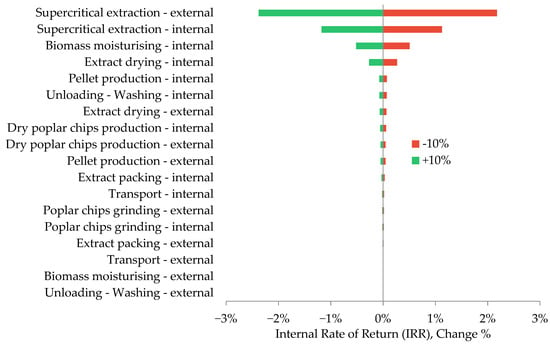
Figure 13.
Tornado diagram of the effects of internal and external costs on the change in the IRR in business model BM I.
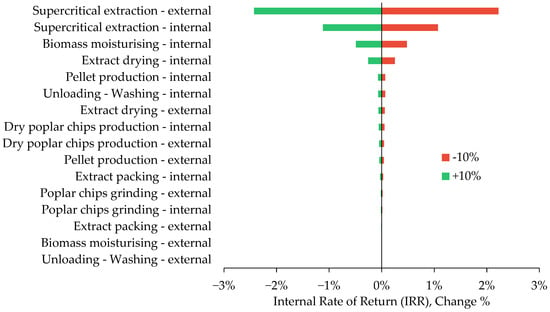
Figure 14.
Tornado diagram of the effects of internal and external costs on the change in the IRR in business model BM II.
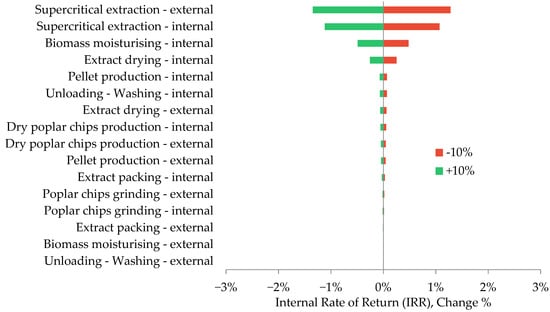
Figure 15.
Tornado diagram of the effects of internal and external costs on the change in the IRR in business model BM I EU.
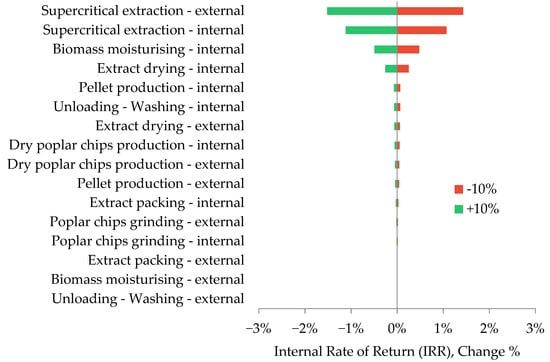
Figure 16.
Tornado diagram of the effects of internal and external costs on the change in the IRR in business model BM II EU.
The results of the analysis of the impacts of particular costs on the Net Present Value were characterized by the same structure as the ones concerning the IRR but also demonstrated the extent of the change in the NPV (Figure 17, Figure 18, Figure 19 and Figure 20). The highest NPV variation resulting from a change in the external costs due to the electric power at a level of ±10% was identified in model BM II, where the NPV variation reached ±€166,132 (Figure 18), and the second most sensitive model was BM I, where the impact value was ±€154,570 (Figure 17). The use of electricity, which generated lower costs in models BM I EU and BM II, decreased the range of sensitivities of the NPV by about 1/3, i.e., to ±€94,294 for BM I EU and ±€105,856 for BM II (Figure 19 and Figure 20, respectively).
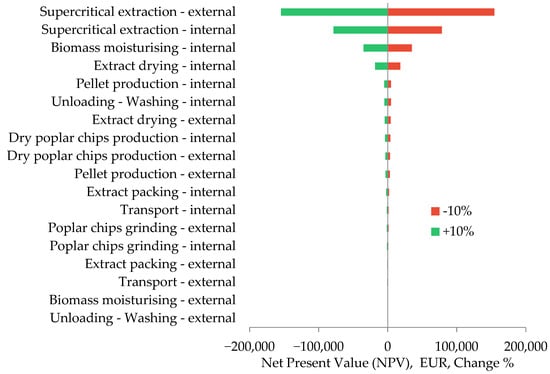
Figure 17.
Tornado diagram of the effects of internal and external costs on the change in the NPV in business model BM I.
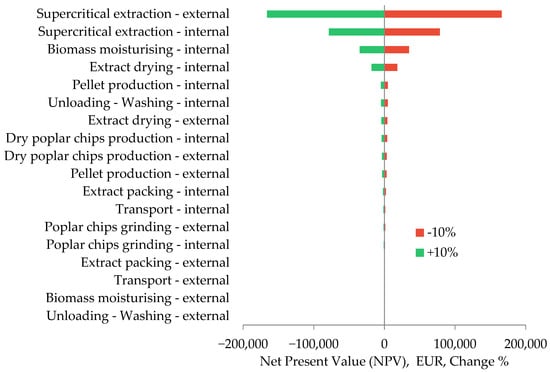
Figure 18.
Tornado diagram of the effects of internal and external costs on the change in the NPV in business model BM II.

Figure 19.
Tornado diagram of the effects of internal and external costs on the change in the NPV in business model BM I EU.
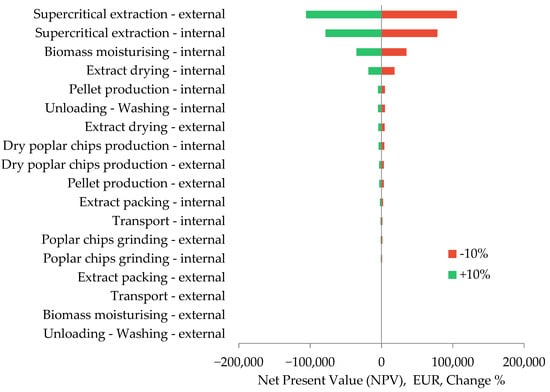
Figure 20.
Tornado diagram of the effects of internal and external costs on the change in the NPV in business model BM II EU.
3.4. Statistical Analysis
Monte Carlo simulations enabled us to assess the conditions underlying the profitability of the extract production, including both external costs and environmental costs. The standard deviation value assumed in the study approximated the values gathered by Miškolci [71], where the standard deviations of the WTP were 10.96%, 13.18%, and 16.92%, depending on the study. The highest value of the expected mean NPV, and the only positive one, was achieved for BM II EU (Table 6). The values of the 68% NPV confidence interval were from €−568,084 to €568,502, indicating a high probability of the lack of profitability in this model. Our analysis of the remaining models generated negative values for the expected mean NPVs, which, under the analyzed market conditions, would prevent the building of a profitable business model in which the environmental costs would be included in the market price of the extract. Hence, further studies and comparative analyses are needed to determine new market conditions for the bioeconomy. The results of the business models analyzed in our study implicate that the most profitable models are developed based on the cascade use of the biomass and a greater share of RES in the generation of the electricity used in technological processes.

Table 6.
Results of Monte Carlo simulations.
Our study also included a test on the significance of the differences between the BEP profitability threshold determined based on internal costs and the profitability threshold in which both internal and external costs were taken into account. The p-value obtained in Friedman’s ANOVA with Kendall’s concordance coefficients was p = 0.04550. This result attested to the validity of the research hypothesis, indicating that the inclusion of the environmental external costs of poplar extract production with the supercritical extraction method has a significant effect on elevating the profitability threshold of the poplar extract production. The BEP values are shown in Figure 21.
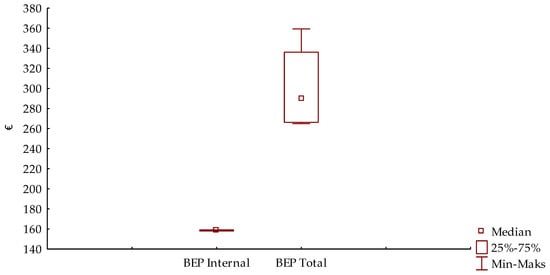
Figure 21.
BEPs’ descriptive statistics.
4. Conclusions
The analysis of the production of poplar extract containing bioactive substances covered all the production stages and all the production costs, which enabled us to determine the external costs in a life cycle. Among the environmental impact categories, the highest external costs were associated with global warming and fossil resource scarcity.
The highest external costs and the strongest impact on the profitability of the production were identified at the supercritical extraction stage. The sensitivity analysis let us identify the source of such high costs in the electricity produced from coal. Models in which electricity was replaced with the EU energy mix, generated with a greater contribution of RES, enabled the reduction of external costs at this and other production stages. A considerable reduction in the external costs at the supercritical extraction stage was reflected in the lower values of the total cost, life cycle cost, and break-even price of the extract production. Supercritical extraction carried out with the use of electricity produced from coal generated high external costs due to the resource used for electricity generation rather than the amount of energy consumed by the process. Moreover, supercritical extraction is a process that potentially enables one to avoid external costs incurred by other methods as it does not use toxic solvents and reduces the emission of CO2, which can be reused.
The analysis of the business model in which pellets were another marketable product showed that the BEP of the extract was decreased but the external costs and LCC value rose considerably. Of the analyzed main business models, lower externalities and, therefore, lower total costs were achieved in BM I. The external costs were lowered using pellets for their own energy purposes, thus reducing the demand for heat generated from fossil fuels. However, the profitability analysis showed that BM II was a more profitable model than BM I. The income generated from selling pellets surpassed the higher external costs in BM II in comparison with BM I, where the external costs were lower. Raising the share of RES in the generation of energy, both electricity (confirmed by the lower external costs in BM I EU and BM II EU) and heat (which led to a reduction in the external costs in BM I) results in the lowering of external costs in the production of bioproducts, which means less damage to the natural environment. The most profitable models entailed the cascade use of the biomass and the highest share of RES in energy generation. The study confirmed that the inclusion of the environmental external costs of the poplar extract production with supercritical extraction had a significant effect on elevating the production profitability threshold. The external costs of the production should be taken into account in the price of a product. This value should be allocated to measures taken to protect the environment and its restoration to the natural state. Our study has demonstrated the need to undertake further research to determine new market conditions because a detailed analysis of one product can lead to erroneous conclusions about the unprofitability of making bioproducts. The detailed scope and method for conducting such investigations is beyond the objective of this paper and will require further research.
An analysis of external costs can serve as a method for assessing various types of production technologies.
The authors are aware that an assessment of external costs from the viewpoint of society is equally important, and this is partly reflected in some of the impact categories, e.g., human health, human carcinogenic toxicity, human non-carcinogenic toxicity, and, indirectly, in the category of fine particulate matter formation, but social life cycle costs were not the subject of this study.
Author Contributions
Conceptualization, E.O.-Z.; methodology, E.O.-Z.; software, E.O.-Z. and M.K.; validation, E.O.-Z.; formal analysis, E.O.-Z.; investigation, E.O.-Z.; M.K.; resources, E.O.-Z. and M.J.S.; data curation, E.O.-Z., M.K. and M.J.S.; writing—original draft preparation, E.O.-Z.; writing—review and editing, E.O.-Z. and M.J.S.; visualization, E.O.-Z.; supervision, E.O.-Z. and M.J.S.; project administration, E.O.-Z. and M.J.S.; funding acquisition, E.O.-Z. and M.J.S. All authors have read and agreed to the published version of the manuscript.
Funding
The results presented in this paper were obtained as a part of a comprehensive study financed by the University of Warmia and Mazury in Olsztyn, the Faculty of Agriculture and Forestry, and the Department of Genetics, Plant Breeding, and Bioresource Engineering (grant No. 30.610.007-110). The study was also co-financed by the National (Polish) Centre for Research and Development (NCBiR) (No. BIOSTRATEG3/344253/2/NCBR/2017). The project is titled “Environment, Agriculture, and Forestry: BIOmagic–BIOproducts from Lignocellulosic Biomass Derived from Marginal Land to Fill the Gap in the Current National Bioeconomy”. This manuscript was also written as a result of the author’s internship at the University of Thessaly (Greece), which was co-financed by the European Union under the European Social Fund (Operational Program Knowledge Education Development) (POWR.03.05. 00-00-Z310/17) and carried out in the Project Development Program at the University of Warmia and Mazury in Olsztyn.
Data Availability Statement
Data are contained within the article.
Acknowledgments
We would like to thank the Supercritical Extraction Department, Łukaszewicz Research Network—New Chemical Syntheses Institute (Puławy, Poland) and ChemProfLtd. (Olsztyn, Poland) for consultations and assistance in collecting the data.
Conflicts of Interest
The authors declare no conflict of interest.
References
- Hamelin, L.; Borzęcka, M.; Kozak, M.; Pudełko, R. A spatial approach to bioeconomy: Quantifying the residual biomass potential in the EU-27. Renew. Sustain. Energy Rev. 2019, 100, 127–142. [Google Scholar] [CrossRef]
- Cosentino, S.L.; Testa, G.; Scordia, D.; Alexopoulou, E. Future yields assessment of bioenergy crops in relation to climate change and technological development in Europe. Ital. J. Agron. 2012, 7, 22. [Google Scholar] [CrossRef]
- McKenney, D.W.; Yemshanou, D.; Fraleigh, S.; Allen, D.; Preto, F. An economic assessment of the use of short-rotation coppice woody biomass to heat greenhouses in southern Canada. Biomass Bioenergy 2011, 35, 374–384. [Google Scholar] [CrossRef]
- Olba-Zięty, E.; Stolarski, M.J.; Krzyżaniak, M. Economic evaluation of the production of perennial crops for energy purposes—A review. Energies 2021, 14, 7147. [Google Scholar] [CrossRef]
- Stolarski, M.J.; Rosenqvist, H.; Krzyżaniak, M.; Szczukowski, S.; Tworkowski, J.; Gołaszewski, J.; Olba-Zięty, E. Economic comparison of growing different willow cultivars. Biomass Bioenergy 2015, 81, 210–215. [Google Scholar] [CrossRef]
- Stanton, B.J.; Bourque, A.; Coleman, M.; Eisenbies, M.; Emerson, R.M.; Espinoza, J.; Gantz, C.; Himes, A.; Rodstrom, A.; Shuren, R.; et al. The practice and economics of hybrid poplar biomass production for biofuels and bioproducts in the Pacific Northwest. Bioenergy Res. 2021, 14, 543–560. [Google Scholar] [CrossRef]
- San Miguel, G.; Corona, B.; Ruiz, D.; Landholm, D.; Laina, R.; Tolosana, E.; Sixto, H.; Canellas, I. Environmental, energy and economic analysis of a biomass supp chain based on a poplar short rotation coppice in Spain. Ind. Crop. Prod. 2015, 94, 93–101. [Google Scholar] [CrossRef]
- Acuna, E.; Rubilar, R.; Cancino, J.; Albaugh, T.J.; Maier, C.A. Economic assessment of Eucalyptus globulus short rotation energy crops under contrasting silvicultural intensities on marginal agricultural land. Land Use Policy 2018, 76, 329–337. [Google Scholar] [CrossRef]
- Tyśkiewicz, K.; Konkol, M.; Kowalski, R.; Rój, E.; Warmiński, K.; Krzyżaniak, M.; Gil, Ł.; Stolarski, M.J. Characterization of bioactive compounds in the biomass of black locust, poplar and willow. Trees Struct. Funct. 2019, 33, 1235–1263. [Google Scholar] [CrossRef]
- Peng, W.; Li, D.; Zhang, M.; Mo, S.G.B.; Li, S.; Ohkoshi, M. Characteristics of antibacterial molecular activities in poplar wood extractives. Saudi J. Biol. Sci. 2017, 24, 399–404. [Google Scholar] [CrossRef]
- Ostolski, M.; Adamczak, M.; Brzozowski, B.; Wiczkowski, W. Antioxidant activity and chemical characteristics of supercritical CO2 and water extracts from willow and poplar. Molecules 2021, 26, 545. [Google Scholar] [CrossRef] [PubMed]
- Walter, M.; Brzozowski, B.; Adamczak, M. Effect of supercritical extract from black poplar and basket willow on the quality of natural and probiotic drinkable yogurt. Animals 2021, 11, 2997. [Google Scholar] [CrossRef] [PubMed]
- Devappa, R.K.; Rakshit, S.K.; Dekker, R.F.H. Forest biorefinery: Potential of poplar phytochemicals as value-added co-products. Biotechnol. Adv. 2015, 33, 681–716. [Google Scholar] [CrossRef] [PubMed]
- Kuś, P.; Jerković, I.; Jakovljević, M.; Jokić, S. Extraction of bioactive phenolics from black poplar (Populus nigra L.) buds by supercritical CO2 and its optimization by response surface methodology. J. Pharm. Biomed. 2018, 152, 128–136. [Google Scholar] [CrossRef]
- Kuś, P.M.; Okińczyc, P.; Jakovljević, M.; Jokić, S.; Jerković, I. Development of supercritical CO2 extraction of bioactive phytochemicals from black poplar (Populus nigra L.) buds followed by GC–MS and UHPLC-DAD-QqTOF-MS. J. Pharm. Biomed. 2018, 158, 15–27. [Google Scholar] [CrossRef]
- D’Amato, D.; Gaio, M.; Semenzin, E. A review of LCA assessments of forest-based bioeconomy products and processes under an ecosystem services perspective. Sci. Total Environ. 2020, 706, 135859. [Google Scholar] [CrossRef]
- Degieter, M.; Gellynck, X.; Goyal, S.; Ott, D.; De Steur, H. Life cycle cost analysis of agri-food products: A systematic review. Sci. Total Environ. 2022, 850, 158012. [Google Scholar] [CrossRef]
- Albuquerque, T.L.M.; Mattos, C.A.; Scur, G.; Kissimoto, K. Life cycle costing and externalities to analyze circular economy strategy: Comparison between aluminum packaging and tinplate. J. Clean. Prod. 2019, 234, 477–486. [Google Scholar] [CrossRef]
- Stern, N. The economics of climate change. Am. Econ. Rev. 2008, 98, 1–37. [Google Scholar] [CrossRef]
- Zhang, Q.; Meng, X.; Shi, S.; Kan, L.; Chen, R.; Kan, H. Overview of particulate air pollution and human health in China: Evidence, challenges, and opportunities. Innovation 2022, 3, 100312. [Google Scholar] [CrossRef]
- Ko, U.W.; Kyung, S.Y. Adverse Effects of Air Pollution on Pulmonary Diseases. Tuberc. Respir. Dis. 2022, 85, 313–319. [Google Scholar] [CrossRef]
- Drudi, F.; Moench, E.; Holthausen, C.; Weber, P.-F.; Ferrucci, G.; Setzer, R.; Nino, V.D.; Barbiero, F.; Faccia, D.; Breitenfellner, A. Climate Change and Monetary Policy in the Euro Area; European Central Bank: Frankfurt am Main, Germany, 2021. [Google Scholar]
- He, L.Y.; Ou, J.J. Pollution emissions, environmental policy, and marginal abatement costs. Int. J. Environ. Health Res. 2017, 14, 1509. [Google Scholar] [CrossRef] [PubMed]
- Carlqvist, K.; Wallberg, O.; Lidén, G.; Börjesson, P. Life cycle assessment for identification of critical aspects in emerging technologies for the extraction of phenolic compounds from spruce bark. J. Clean. Prod. 2022, 333, 130093. [Google Scholar] [CrossRef]
- Khoo, H.H.; Eufrasio-Espinosa, R.M.; Koh, L.S.C.; Sharratt, P.N.; Isoni, V. Sustainability assessment of biorefinery production chains: A combined LCA-supply chain approach. J. Clean. Prod. 2019, 235, 1116–1137. [Google Scholar] [CrossRef]
- Canaj, K.; Mehmeti, A.; Berbel, J. The economics of fruit and vegetable production irrigated with reclaimed water incorporating the hidden costs of life cycle environmental impacts. Resources 2021, 10, 90. [Google Scholar] [CrossRef]
- Canaj, K.; Mehmeti, A.; Morrone, D.; Toma, P.; Todorović, M. Life cycle-based evaluation of environmental impacts and external costs of treated wastewater reuse for irrigation: A case study in southern Italy. J. Clean. Prod. 2021, 293, 126142. [Google Scholar] [CrossRef]
- Santoso, A.D. Life Cycle Costing and Externalities of Palm Biodiesel and Algae Biodiesel in Indonesia. Int. J. Sci. Technol. Manag. 2013, 2, 6–15. [Google Scholar]
- Finnveden, G. A Critical Review of Operational Valuation/Weighting Methods for Life Cycle Assessment; Preparation; Påuppdrag av AFN vid Naturvårdsverket; Stockholm 1999. Swedish Environmental Protection Agency. Available online: https://citeseerx.ist.psu.edu/document?repid=rep1&type=pdf&doi=14af1db100de8156498cd151cf73480311c9954f (accessed on 11 February 2023).
- Johansson, J. A Monetary Valuation Weighting Method for Life Cycle Assessment Based on Environmental Taxes and Fees. Master’s Thesis, Department of Systems Ecology, Stockholm University, Stockholm, Sweden, 1999. [Google Scholar]
- Amadei, A.M.; De Laurentiis, V.; Sala, S. A review of monetary valuation in life cycle assessment: State of the art and future needs. J. Clean. Prod. 2021, 329, 129668. [Google Scholar] [CrossRef]
- Finnveden, G.; Eldh, P.; Johansson, J. Weighting in LCA based on ecotaxes: Development of a mid-point method and experiences from case studies. Int. J. LCA 2006, 11, 81–88. [Google Scholar] [CrossRef]
- Finnveden, G.; Håkansson, C.; Noring, M. A new set of valuation factors for LCA and LCC based on damage costs: Ecovalue 2012. In Perspectives on Managing Life Cycles: Proceedings of the 6th International Conference on Life Cycle Management, Gothenburg, Sweden, 25–28 August 2013; Association LCM: Lambersart, France, 2013; pp. 197–200. [Google Scholar]
- Vogtländer, J.G.; Brezet, H.C.; Hendriks, C.F. The virtual eco-costs ‘99 A single LCA-based indicator for sustainability and the eco-costs-value ratio (EVR) model for economic allocation. Int. J. LCA 2001, 6, 157–166. [Google Scholar] [CrossRef]
- Steen, B. A systematic approach to environmental priority strategies in product development (EPS). In Version 2000—Models and Data of Default Method; Chalmers Tekniska Högsk: Gothenburg, Sweden, 1999; p. 67. [Google Scholar]
- De Bruyn, S.; Bijleveld, M.; de Graaff, L.; Schep, E.; Schroten, A.; Vergeer, R.; Ahdour, S. Environmental Prices Handbook Eu28 Version—Methods and Numbers for Valuation of Environmental Impacts; CE Delft: Delft, The Netherlands, 2018. [Google Scholar]
- Ferreira, S.; Cabral, M.; da Cruz, N.F.; Marques, R.C. Economic and environmental impacts of the recycling system in Portugal. J. Clean. Prod. 2014, 79, 219–230. [Google Scholar] [CrossRef]
- Itsubo, N.; Murakami, K.; Kuriyama, K.; Yoshida, K.; Tokimatsu, K.; Inaba, A. Development of weighting factors for G20 countries—Explore the difference in environmental awareness between developed and emerging countries. Int. J. LCA 2018, 23, 2311–2326. [Google Scholar] [CrossRef]
- Itsubo, N.; Sakagami, M.; Kuriyama, K.; Inaba, A. Statistical analysis for the development of national average weighting factors-visualization of the variability between each individual’s environmental thought. Int. J. LCA 2012, 17, 488–498. [Google Scholar] [CrossRef]
- Jolliet, O.; Margni, M.; Charles, R.; Humbert, S.; Payet, J.; Rebitzer, G.; Rosenbaum, R. IMPACT 2002+: A new life cycle impact assessment methodology. Int. J. LCA 2003, 8, 324–330. [Google Scholar] [CrossRef]
- Bickel, P.; Friedrich, R. ExternE Externalities of Energy: Methodology 2005 Update (9279004239); European Communities: Brussels, Belgium, 2005. [Google Scholar]
- Weidema, B.P. Using the budget constraint to monetarise impact assessment results. Ecol. Econ. 2009, 68, 1591–1598. [Google Scholar] [CrossRef]
- Rosenbaum, R.K.; Bachmann, T.M.; Gold, L.S.; Huijbregts, M.A.; Jolliet, O.; Juraske, R.; Koehler, A.; Larsen, H.F.; MacLeod, M.; Margni, M.; et al. USEtox—The UNEP-SETAC toxicity model: Recommended characterisation factors for human toxicity and freshwater ecotoxicity in life cycle impact assessment. Int. J. LCA 2008, 13, 532–546. [Google Scholar] [CrossRef]
- Pizzol, M.; Weidema, B.; Brandão, M.; Osset, P. Monetary valuation in Life Cycle Assessment: A review. J. Clean. Prod. 2015, 86, 170–179. [Google Scholar] [CrossRef]
- Arendt, R.; Bachmann, T.M.; Motoshita, M.; Bach, V.; Finkbeiner, M. Comparison of different monetization methods in LCA: A review. Sustainability 2020, 12, 10493. [Google Scholar] [CrossRef]
- Jorli, M.; Van Passel, S.; Sadeghi Saghdel, H. External costs from fossil electricity generation: A review of the applied impact pathway approach. Energy Environ. 2018, 29, 635–648. [Google Scholar] [CrossRef]
- Sovacool, B.K.; Kim, J.; Yang, M. The hidden costs of energy and mobility: A global meta-analysis and research synthesis of electricity and transport externalities. Energy Res. Soc. Sci. 2021, 72, 101885. [Google Scholar] [CrossRef]
- Fersi, S.; Chtourou, N. Internalizing the external costs of renewable energy projects through stepwise method—A comparative study. J. Clean. Prod. 2022, 371, 133607. [Google Scholar] [CrossRef]
- Olba-Zięty, E.; Stolarski, M.J.; Krzyżaniak, M.; Gołaszewski, J. Environmental external cost of poplar wood chips sustainable production. J. Clean. Prod. 2020, 252, 119854. [Google Scholar] [CrossRef]
- Olba-Zięty, E.; Stolarski, M.J.; Krzyżaniak, M.; Warmiński, K. Willow Cultivation as Feedstock for Bioenergy-External Production Cost. Energies 2020, 13, 4799. [Google Scholar] [CrossRef]
- Saosee, P.; Sajjakulnukit, B.; Gheewala, S.H. Environmental externalities of wood pellets from fast-growing and para-rubber trees for sustainable energy production: A case in Thailand. Energy Convers. Manag. 2022, 14, 100183. [Google Scholar] [CrossRef]
- Rodríguez-Vallejo, D.F.; Guillén-Gosálbez, G.; Chachuat, B. What Is the True Cost of Producing Propylene from Methanol? The Role of Externalities. ACS Sustain. Chem. Eng. 2020, 8, 3072–3081. [Google Scholar] [CrossRef]
- Tobiszewski, M.; Bystrzanowska, M. Monetary values estimates of solvent emissions. Green Chem. 2020, 22, 7983–7988. [Google Scholar] [CrossRef]
- Eidelwein, F.; Collatto, D.C.; Rodrigues, L.H.; Lacerda, D.P.; Piran, F.S. Internalization of environmental externalities: Development of a method for elaborating the statement of economic and environmental results. J. Clean. Prod. 2018, 170, 1316–1327. [Google Scholar] [CrossRef]
- Olba-Zięty, E.; Stolarski, M.J.; Krzyżaniak, M.; Rój, E.; Tyśkiewicz, K.; Łuczyński, M.K. Supercritical production of extract from poplar containing bioactive substances—An economic analysis. Ind. Crops Prod. 2022, 184, 115094. [Google Scholar] [CrossRef]
- Ponsioen, T.; Nuhoff-Isakhanyan, G.; Vellinga, T.; Baltussen, W.; Boone, K.; Woltjer, G. Monetisation of Sustainability Impacts of Food Production and Consumption; Wageningen Economic Research: The Hague, The Netherlands, 2020. [Google Scholar] [CrossRef]
- Viganó, J.; Zabot, G.L.; Martínez, J. Supercritical fluid and pressurized liquid extractions of phytonutrients from passion fruit by-products: Economic evaluation of sequential multi-stage and single-stage processes. J. Supercrit. Fluids. 2017, 122, 88–98. [Google Scholar] [CrossRef]
- Bryła, P. Marketing Regionalnych i Ekologicznych Produktów Żywnościowych. Perspektywa Sprzedawcy i Konsumenta (Marketing of Regional and Organic Food Products. Seller and Consumer Perspective); Wydawnictwo Uniwersytetu Łódzkiego: Łódź, Poland, 2015. [Google Scholar]
- Lu, K.; Jiang, X.; Yu, J.; Tam VW, Y.; Skitmore, M. Integration of life cycle assessment and life cycle cost using building information modeling: A critical review. J. Clean. Prod. 2021, 285, 125438. [Google Scholar] [CrossRef]
- Eurostat. Share of RES in Electricity Generation from all Sources. 2023. Available online: https://ec.europa.eu/eurostat/web/energy/data/shares (accessed on 11 February 2023).
- Saosee, P.; Sajjakulnukit, B.; Gheewala, S.H. Environmental and socio-economic assessment of wood pellet production from fast growing trees in Thailand. IOP Conf. Ser. Earth Environ. Sci. 2020, 463, 012049. [Google Scholar] [CrossRef]
- Stolarski, M.J.; Krzyżaniak, M.; Szczukowski, S.; Tworkowski, J.; Załuski, D.; Bieniek, A.; Gołaszewski, J. Effect of increased soil fertility on the yield and energy value of short-rotation woody crops. Bioenergy Res. 2015, 8, 1136–1147. [Google Scholar] [CrossRef]
- Epstein, P.R.; Buonocore, J.J.; Eckerle, K.; Hendryx, M.; Stout Iii, B.M.; Heinberg, R.; Clapp, R.W.; May, B.; Reinhart, N.L.; Ahern, M.M. Full cost accounting for the life cycle of coal. Ann. N. Y. Acad. 2011, 1219, 73–98. [Google Scholar] [CrossRef] [PubMed]
- Treyer, K.; Bauer, C.; Simons, A. Human health impacts in the life cycle of future European electricity generation. Energy Policy 2014, 74, S31–S44. [Google Scholar] [CrossRef]
- De Marco, I.; Riemma, S.; Iannone, R. Life cycle assessment of supercritical CO2 extraction of caffeine from coffee beans. J. Supercrit. Fluids 2018, 133, 393–400. [Google Scholar] [CrossRef]
- Panzella, L.; Moccia, F.; Nasti, R.; Marzorati, S.; Verotta, L.; Napolitano, A. Bioactive Phenolic Compounds From Agri-Food Wastes: An Update on Green and Sustainable Extraction Methodologies. Front. Nutr. 2020, 7, 60. [Google Scholar] [CrossRef]
- Albuquerque, C.L.C.; Meireles, M.A.A. Defatting of annatto seeds using supercritical carbon dioxide as a pretreatment for the production of bixin: Experimental, modeling and economic evaluation of the process. J. Supercr. Fluids 2012, 66, 86–95. [Google Scholar] [CrossRef]
- Todd, R.; Baroutian, S. A techno-economic comparison of subcritical water, supercritical CO2 and organic solvent extraction of bioactives from grape marc. J. Clean. Prod. 2017, 158, 349–358. [Google Scholar] [CrossRef]
- Canabarro, N.I.; Veggi, P.C.; Vardanega, R.; Mazutti, M.A.; Ferreira, M.D.C. Techno-economic evaluation and mathematical modeling of supercritical CO2 extraction from Eugenia uniflora L. leaves. J. Appl. Res. Med. Aromat. Plants. 2020, 18, 100261. [Google Scholar] [CrossRef]
- Liu, W.; Wang, J.; Richard, T.L.; Hartley, D.S.; Spatari, S.; Volk, T.A. Economic and life cycle assessments of biomass utilization for bioenergy products. Biofuel Bioprod. Biorefin. 2017, 11, 633–647. [Google Scholar] [CrossRef]
- Miškolci, S. Consumer preferences and willingness to pay for the health aspects of food. Acta Univ. Agric. Silvic. Mendel. Brun. 2011, 59, 167–176. [Google Scholar] [CrossRef]
Disclaimer/Publisher’s Note: The statements, opinions and data contained in all publications are solely those of the individual author(s) and contributor(s) and not of MDPI and/or the editor(s). MDPI and/or the editor(s) disclaim responsibility for any injury to people or property resulting from any ideas, methods, instructions or products referred to in the content. |
© 2023 by the authors. Licensee MDPI, Basel, Switzerland. This article is an open access article distributed under the terms and conditions of the Creative Commons Attribution (CC BY) license (https://creativecommons.org/licenses/by/4.0/).